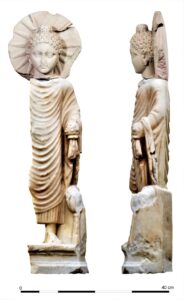 A marble statuette of the Buddha has been discovered at the Roman-era Temple of Isis in Berenike on Egypt’s Red Sea coast. It dates to the 2nd century A.D. when the Red Sea ports of Roman Egypt were crucial stops on the trade networks linking the Roman Empire to India. This is the most definitive archaeological evidence found of Buddhism in ancient Egypt.
A marble statuette of the Buddha has been discovered at the Roman-era Temple of Isis in Berenike on Egypt’s Red Sea coast. It dates to the 2nd century A.D. when the Red Sea ports of Roman Egypt were crucial stops on the trade networks linking the Roman Empire to India. This is the most definitive archaeological evidence found of Buddhism in ancient Egypt.
Egypt was at the center of a trade route that connected the Roman Empire with many areas of the ancient world, including India. There were several Roman-era harbors on the Red Sea coast of Egypt involved in this commerce, the most important of which was Berenike. Ships from India arrived there with products, such as pepper, semi-precious stones, textiles, and ivory. At Berenike, they were offloaded, and the cargo was transferred to camels that conveyed the goods across the desert to the Nile. Other ships then transported the merchandise to Alexandria and, from there, to the rest of the Roman Empire.
Found in the forecourt of the temple, the figure is 28 inches high and depicts Buddha standing holding part of his draped robe in his left hand. Around his head is a halo with sunrays that represents his radiant mind. A lotus flower (a symbol of purity) grows by his left foot. The workmanship of the carving is very fine.
The marble is of very high quality and was quarried from an area south of Istanbul. It was carved by local artisans in Berenike who sold their wares to the international merchant community. An Indian trader (or traders) likely acquired this figurine as a votive offering to dedicate at the Isis Temple.
Archaeologists also found two 2nd century coins from the central Indian Satavahana dynasty (2nd c. B.C. – 3rd c. A.D.) in the temple precinct, and a Sanskrit inscription dating to the rule of the emperor Philip the Arab (244–249 A.D.).